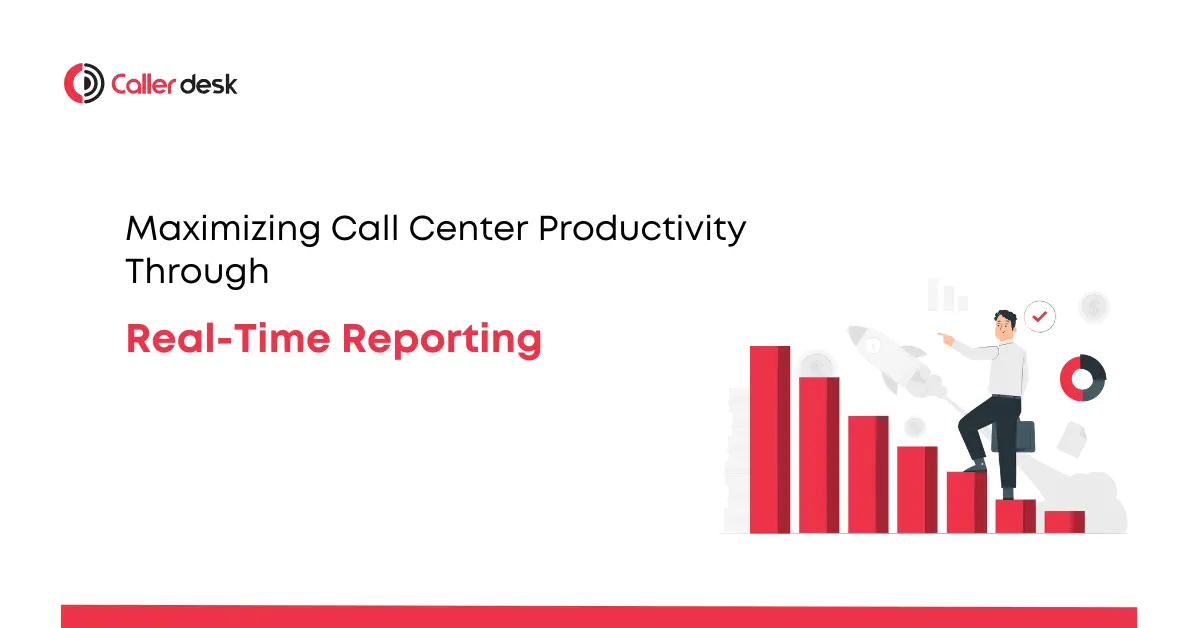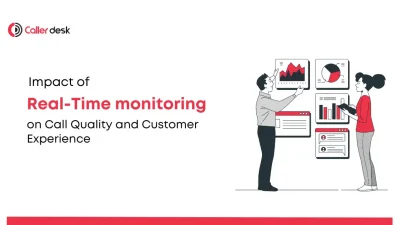Are you able to spot issues in your call center the moment they arise, or do you only discover them after they’ve already impacted your operations? In today’s fast-paced business environment, reacting to problems is no longer enough. To remain competitive and deliver exceptional customer service, call centers must adopt a proactive approach.
One of the most effective ways to achieve this is by leveraging real-time reporting. This powerful feature provides immediate insights into call center operations, enabling managers to make swift, data-driven decisions that enhance agent performance, improve customer experiences, and boost overall productivity. By identifying bottlenecks, addressing challenges, and reallocating resources instantly, real-time reporting gives call centers the agility they need to thrive in a highly competitive market.
In this article, we’ll explore what real-time reporting is, its key benefits, and how you can implement it to transform your call center’s efficiency and outcomes.
What is Real-Time Reporting in Call Centers?
Real-time reporting refers to the ability to access and analyze live data on call center operations as events occur. Unlike traditional reporting, which relies on historical data, real-time reporting provides up-to-the-minute information on critical metrics, such as:
- Call volume: The number of calls being handled at any given time.
- Wait times: How long customers are waiting to connect with an agent.
- Agent performance: Metrics such as average handling time (AHT) and first-call resolution (FCR).
- Customer satisfaction (CSAT): Insights into the quality of service delivered during interactions.
With real-time reporting, call center managers can monitor live activities, quickly identify emerging issues, and implement corrective actions instantly. This immediate access to data ensures that operations remain smooth, resources are optimally allocated, and customer satisfaction stays high.
Key Benefits of Real-Time Reporting for Call Center Productivity
1. Improved Agent Efficiency
- Live Performance Monitoring: Managers can track KPIs like the number of calls handled, call duration, and resolution rates in real time. This visibility allows them to address performance gaps promptly.
- Quick Interventions: If an agent struggles during a call or deviates from scripts, managers can step in to offer real-time guidance or coaching, ensuring consistent service quality.
- Motivated Teams: Providing immediate feedback keeps agents motivated and engaged, fostering a culture of continuous improvement.
2. Enhanced Customer Satisfaction
- Proactive Problem-Solving: Real-time monitoring enables managers to identify and resolve customer issues as they occur, preventing escalation and ensuring positive outcomes.
- Faster Response Times: With instant access to live data, call centers can address customer concerns more quickly, reducing wait times and improving satisfaction rates.
- Personalized Interactions: Insights into customer sentiment during calls help agents adapt their approach to deliver empathetic and tailored service.
3. Optimized Resource Allocation
- Align Staffing with Demand: Real-time data highlights peak call times, enabling managers to adjust staffing levels dynamically to match demand. This minimizes long wait times and ensures adequate coverage.
- Cost Savings: By balancing workloads and avoiding overstaffing or understaffing, call centers can reduce operational costs while maintaining high efficiency.
4. Ensuring Compliance and Quality
- Proactive Compliance Monitoring: Real-time reporting tracks whether agents adhere to scripts, industry regulations, and company policies. Alerts can flag potential violations immediately, reducing legal and reputational risks.
- Maintaining High Standards: By monitoring live calls, managers can ensure that agents consistently meet service quality benchmarks, reinforcing trust with customers.
5. Actionable Insights for Continuous Improvement
- Data-Driven Decisions: Real-time reporting provides actionable insights into agent performance and customer interactions. This data helps managers identify trends, optimize processes, and refine strategies to achieve better outcomes.
- Enhanced Training Programs: Insights into agent strengths and weaknesses enable managers to develop tailored coaching sessions, helping agents improve their skills and performance over time.
6. Predictive Problem Solving
- Anticipating Customer Needs: By analyzing trends in real-time, call centers can predict potential customer pain points and proactively address them.
- Preventing Downtime: Monitoring system performance in real-time allows IT teams to identify and resolve technical issues before they impact operations.
How to Implement Real-Time Reporting for Success
Step 1: Select the Right Platform
Choose a cloud-based call center solution like CallerDesk that offers robust real-time reporting features. Look for tools with:
- User-friendly dashboards for monitoring key metrics.
- Integration capabilities with existing systems (e.g., CRM and helpdesk platforms).
- Scalability to grow alongside your business.
Step 2: Leverage Built-In Reporting Features
Maximize the potential of your software by using its built-in dashboards to track critical KPIs like CSAT, AHT, and FCR. Schedule automated reports to keep all stakeholders informed and align strategies with performance goals.
Step 3: Train Your Team
Equip your managers and agents with the knowledge to interpret and act on real-time data. Regular training ensures they can effectively use the reporting tools and make data-driven decisions that enhance performance.
Step 4: Integrate Advanced Analytics
Enhance your real-time reporting capabilities with advanced analytics tools. These solutions provide deeper insights into customer behavior, agent performance, and operational efficiency, helping you stay ahead of challenges.
Step 5: Use Feedback to Drive Improvement
Real-time reporting is most effective when paired with actionable feedback. Use the insights gained to:
- Provide constructive feedback to agents.
- Refine workflows to eliminate bottlenecks.
- Update training materials based on emerging trends and needs.
Why Choose CallerDesk for Real-Time Reporting?
CallerDesk is a trusted partner for businesses seeking to optimize their call center operations. With industry-leading real-time reporting features, CallerDesk empowers call centers to:
- Monitor Live Metrics: Track agent performance, call quality, and customer satisfaction in real-time.
- Enhance Decision-Making: Leverage AI-driven analytics to uncover actionable insights and optimize workflows.
- Improve Resource Allocation: Align staffing levels with demand to maintain efficiency and reduce costs.
- Ensure Compliance: Proactively monitor compliance with industry regulations and company policies.
With CallerDesk, your call center gains the tools and insights needed to deliver exceptional service and drive long-term success.
Conclusion
Real-time reporting is more than a tool—it’s a strategy that transforms the way call centers operate. By offering instant insights into performance metrics, it enables managers to make swift, informed decisions that improve productivity, enhance customer satisfaction, and reduce costs.
For call centers looking to maximize their efficiency and stay ahead in a competitive market, adopting real-time reporting features is a must. With a solution like CallerDesk, you can empower your team, optimize your operations, and deliver superior customer experiences—every time.
Take the next step today. Schedule a free demo with CallerDesk and discover how real-time reporting can revolutionize your call center operations!
Frequently Asked Question
Q1. What is real-time reporting in call centers?
Real-time reporting in call centers refers to the ability to access and analyze live data, such as call volumes, agent performance, and customer satisfaction, as events occur. It helps managers monitor ongoing operations, address issues proactively, and improve overall productivity.
Q2. Why is real-time reporting important for call center productivity?
Real-time reporting empowers call center managers to make swift, data-driven decisions. It improves agent efficiency, enhances customer satisfaction, ensures compliance, optimizes resource allocation, and provides actionable insights for continuous improvement.
Q3. How does real-time reporting improve customer satisfaction?
By monitoring live interactions, managers can address customer concerns instantly, reduce wait times, and ensure personalized service. This proactive approach prevents escalations and enhances customer loyalty.
Q4. Can real-time reporting help reduce operational costs?
Yes, real-time reporting allows call centers to optimize staffing levels, reduce idle time, and improve scheduling based on demand, leading to significant cost savings.
Q5. What metrics can be tracked using real-time reporting?
Common metrics include call volume, average handling time (AHT), first-call resolution (FCR), customer satisfaction (CSAT), wait times, and agent performance.
Q6. How does CallerDesk support real-time reporting?
CallerDesk provides advanced real-time reporting tools, including live dashboards, AI-driven analytics, and integration with CRM platforms. These features help call centers monitor performance, ensure compliance, and make data-driven decisions.
Q7. How can real-time reporting benefit agents?
Real-time reporting allows agents to receive immediate feedback, access live performance metrics, and improve their efficiency through on-the-spot guidance and coaching.
Q8. What role does training play in implementing real-time reporting?
Training ensures that managers and agents can effectively use reporting tools, interpret data, and take timely action. Regular training enhances the effectiveness of real-time reporting and drives better outcomes.
Q9. Is real-time reporting suitable for small call centers?
Yes, real-time reporting is beneficial for call centers of all sizes. It helps small call centers optimize resources, improve efficiency, and deliver high-quality service, even with limited staff.
Q10. How can businesses get started with real-time reporting?
Start by selecting a reliable solution like CallerDesk, train your team to use the tools effectively, and integrate advanced analytics for deeper insights. Schedule a demo with CallerDesk to explore tailored solutions.





